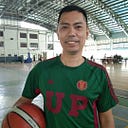What Really Happened in Baker Hall
by Oliver Carlos
When I was a UPLB student, my favorite building in the campus was Baker Hall. It’s not a bakery, canteen or cake shop, as there’s no bread in that building. Baker Hall is the Physical Education facility of the university during my time. It’s named after an American professor who was a pioneer of the said UP campus. The building was erected in 1932 adjacent to 2 large fields that can be used for football, baseball, track-and-field, and other outdoor sports. Later, more sports and PE facilities were added to the complex, like outdoor basketball courts, a pelota court, tennis courts, an archery range, and a swimming pool.

I love Baker Hall because that’s where I played basketball almost every day of my teen years. I played hoops as often as I wanted, sometimes 3 times a day- at dawn after brief jogs, at 1 PM when nobody’s playing, and at evening when the “veterans” or the big grown-up men were done playing. During PE time, my classmates and I own the indoor court. That’s when and where I had the most fun as a teenager.
I spent a lot of time in Baker Hall that I got so familiar with its every corner. One thing I recall is seeing a couple of bronze or brass plaques at the entrance of the building. They talked about what happened in the vicinity during World War 2. One plaque was in English and the other was in Filipino. Both were accounts of a single event, but curiously, they were written in different perspectives.
The one in English says that there were more than 2,000 prisoners interned in Baker area by the Japanese invaders. The POWs were mostly Americans. The others were from the “Free World.” I guess that refers to Britons, French, Australians and New Zealanders. Then on February 23, 1945 they were rescued by American forces composed of paratroopers and ground soldiers who arrived on amphibian vehicles from Laguna de Bay. Meanwhile, the plaque in Filipino told the same details except that the rescue forces were initiated and led by a Filipino guerilla unit called the “Hunters ROTC.”
Every February 23, the living survivors of the “Los Banos Raid” have a reunion at Baker. They were the ex-prisoners and American soldiers who participated in that historical event. They fly all the way from the US just for a simple on-site ceremony. They’re getting fewer and fewer every year though. Soon they may all be gone, but a monument was erected at the back of Baker Hall for them.
When I became a history professor, I made additional research on this. I found out that it was on Baker field, not inside Baker Hall that the prisoners were kept. Their captors built barracks on the 2 fields for them. They were made of sawali and pawid, like long rectangular giant-sized bahay kubos. Baker Hall was used as the garrison and office of the Japanese soldiers.
I learned that it was a joint force that did the rescue job. The Filipino guerillas were the ones who fed intelligence reports to the US forces who were positioned in Alabang. Then the 2 groups launched a surprise attack versus the Japanese beginning 7 A.M. on February 23, 1945. That’s the fact. But as of who deserved the greater credit, the Americans or the Filipinos, that’s now a matter of opinion.
It’s funny to look at hindsight that a single historical event can have more than one interpretation. We see this in the story of the 2 plaques. For the Westerners, they were the heroes, but for us Filipinos, we were the true heroes of the Los Banos Raid.
Similarly, in World History, the person of Jesus Christ is one very controversial issue. One set of historical events in Israel 2,000 years ago can have multiple accounts. Who really is Jesus? For the Jewish leaders who had him crucified, he was an impostor, a blasphemer in their religion. For the Romans who executed the death sentence, Jesus was just another criminal or troublemaker in their conquered territory. But for his disciples, he’s the promised Savior of the world. He was God the Son, God himself who left heaven and came earth to die on the cross to save us from our sins. Peter confessed this in Mark 8:29 (NIV):
“But what about you?” he asked. “Who do you say I am?” Peter answered, “You are the Messiah.”
Just like in Peter’s case, Jesus would be asking you the same question. Who is he to you? Is Jesus just another historical character you read in books? Or is he your Savior, the Lord of the universe, who is also the Lord of your life, living and reigning in your heart?
